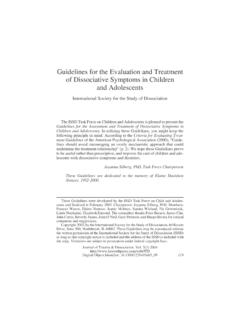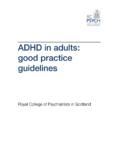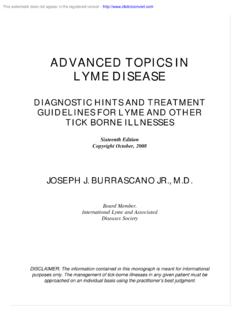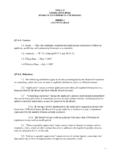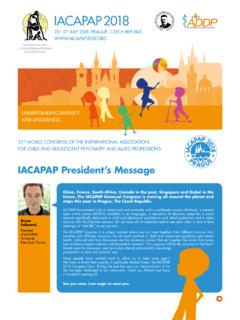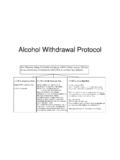Transcription of Guidelines for Treating Dissociative Identity …
1 This article was downloaded by: [ ]. On: 21 October 2011, At: 09:20. Publisher: Routledge Informa Ltd Registered in England and Wales Registered Number: 1072954 Registered office: Mortimer House, 37-41 Mortimer Street, London W1T 3JH, UK. Journal of Trauma & Dissociation Publication details, including instructions for authors and subscription information: Guidelines for Treating Dissociative Identity Disorder in Adults, Third Revision International Society for the Study of Trauma and Dissociation Available online: 03 Mar 2011. To cite this article: International Society for the Study of Trauma and Dissociation (2011): Guidelines for Treating Dissociative Identity Disorder in Adults, Third Revision, Journal of Trauma & Dissociation, 12:2, 115-187. To link to this article: PLEASE SCROLL DOWN FOR ARTICLE. Full terms and conditions of use: This article may be used for research, teaching, and private study purposes.
2 Any substantial or systematic reproduction, redistribution, reselling, loan, sub-licensing, systematic supply, or distribution in any form to anyone is expressly forbidden. The publisher does not give any warranty express or implied or make any representation that the contents will be complete or accurate or up to date. The accuracy of any instructions, formulae, and drug doses should be independently verified with primary sources. The publisher shall not be liable for any loss, actions, claims, proceedings, demand, or costs or damages whatsoever or howsoever caused arising directly or indirectly in connection with or arising out of the use of this material. Journal of Trauma & Dissociation, 12:115 187, 2011. Copyright International Society for the Study of Trauma and Dissociation ISSN: 1529-9732 print/1529-9740 online DOI: ARTICLES. Guidelines for Treating Dissociative Identity Disorder in Adults, Third Revision INTERNATIONAL SOCIETY FOR THE STUDY.
3 OF TRAUMA AND DISSOCIATION. Downloaded by [ ] at 09:20 21 October 2011. FOREWORD. The International Society for the Study of Dissociation (ISSD), the former name of the International Society for the Study of Trauma and Dissociation (ISSTD), adopted the Guidelines for Treating Dissociative Identity Disorder (Multiple Personality Disorder) in Adults in 1994. However, the Guidelines must be responsive to developments in the field and require ongoing review. The first revision of the Guidelines was proposed by the ISSD's Standards of Practice Committee1 and was adopted by the ISSD Executive Council in 1997 after substantial comment from the ISSD membership. The second revision of the Guidelines was requested and approved in 2005 based on the expertise of a task force of expert clinicians and The current Received 10 April 2010; accepted 12 June 2010.
4 Copyright 2011 by the International Society for the Study of Trauma and Dissociation (ISSTD), 8400 Westpark Drive, Second Floor, McLean, VA 22102. The Guidelines may be reproduced without the written permission of the ISSTD as long as this copyright notice is included along with the address of the ISSTD. Violators are subject to prosecution under federal copyright laws. The correct citation for this revision of the Guidelines is as follows: International Society for the Study of Trauma and Dissociation. (2011). [Chu, J. A., Dell, P. F., Van der Hart, O., Carde a, E., Barach, P. M., Somer, E., Loewenstein, R. J., Brand, B., Golston, J. C., Courtois, C. A., Bowman, E. S., Classen, C., Dorahy, M., S ar, V., Gelinas, D. J., Fine, C. G., Paulsen, S., Kluft, R. P., Dalenberg, C. J., Jacobson-Levy, M., Nijenhuis, E. R. S., Boon, S., Chefetz, R.]
5 A., Middleton, W., Ross, C. A., Howell, E., Goodwin, G., Coons, P. M., Frankel, A. S., Steele, K., Gold, S. N., Gast, U., Young, L. M., & Twombly, J.]. Guidelines for Treating Dissociative Identity disorder in adults, third revision. Journal of Trauma & Dissociation, 12, 115 187. Address correspondence to International Society for the Study of Trauma and Dissociation, 8400 Westpark Drive, Second Floor, McLean, VA 22102. E-mail: 115. 116 International Society for the Study of Trauma and Dissociation revision was undertaken by a new task force3 in 2009 and 2010 after input from an open-ended survey of the membership. The current revision of the Guidelines focuses specifically on the treatment of Dissociative Identity disorder (DID) and those forms of disso- ciative disorder not otherwise specified (DDNOS) that are similar to DID. It is intended as a practical guide to the management of adult patients and represents a synthesis of current scientific knowledge and informed clinical practice.
6 There is a separate Guidelines for the Evaluation and Treatment of Dissociative Symptoms in Children and Adolescents (ISSD, 2004) available through the ISSTD and published in the Journal of Trauma & Dissociation. The American Psychiatric Association (2004) has published Practice Guidelines for the Treatment of Patients with Acute Stress Disorder (ASD) and Posttraumatic Stress Disorder (PTSD), which may be relevant to the treatment of DID. Downloaded by [ ] at 09:20 21 October 2011. INTRODUCTION. Over the past 30 years, the diagnosis, assessment, and treatment of dis- sociative disorders have been enhanced by increased clinical recognition of Dissociative conditions, the publication of numerous research and schol- arly works on the subject, and the development of specialized diagnostic instruments. Peer-reviewed publications concerning Dissociative disorders have appeared in the international literature from clinicians and investiga- tors in at least 26 countries, including the United States, Canada, Puerto Rico, Argentina, The Netherlands, Norway, Switzerland, Northern Ireland, Great Britain, France, Germany, Italy, France, Sweden, Spain, Turkey, Israel, Oman, Iran, India, Australia, New Zealand, the Philippines, Uganda, China, and Japan.
7 These publications include clinical case series and case reports;. psychophysiological, neurobiological, and neuroimaging research; discus- sion of the development of diagnostic instruments; descriptions of open clinical trials and treatment outcome studies; and descriptions of treatment, treatment modalities, and treatment dilemmas. They consistently provide evidence that DID is a valid cross-cultural diagnosis that has validity compa- rable to or exceeding that of other accepted psychiatric diagnoses (Gleaves, May, & Carde a, 2001). However, they also note that pathological alterations of Identity and/or consciousness may present in other cultures as spirit pos- session and other culture-bound syndromes (Carde a, Van Duijl, Weiner, &. Terhune, 2009). Key findings and generally accepted principles that reflect current sci- entific knowledge and clinical experience specific to the diagnosis and treat- ment of DID and similar forms of DDNOS are presented in the Guidelines .
8 It should be understood that information in the Guidelines supplements, but does not replace, generally accepted principles of psychotherapy and Journal of Trauma & Dissociation, 12:115 187, 2011 117. psychopharmacology . Treatment for DID should adhere to the basic princi- ples of psychotherapy and psychiatric medical management, and therapists should use specialized techniques only as needed to address specific Dissociative symptomatology. The recommendations in the Guidelines are not intended to be construed as or to serve as a standard of clinical care. The practice rec- ommendations reflect the state of the art in this field at the present time. The Guidelines are not designed to include all proper methods of care or to exclude other acceptable treatment interventions. Moreover, adhering to the Guidelines will not necessarily result in a successful treatment outcome in every case.
9 Treatment should always be individualized, and clinicians must use their judgment concerning the appropriateness for a particular patient of a specific method of care in light of the clinical data presented by the patient and options available at the time of treatment. Downloaded by [ ] at 09:20 21 October 2011. EPIDEMIOLOGY, CLINICAL DIAGNOSIS, AND DIAGNOSTIC. PROCEDURES. DID and Dissociative disorders are not rare conditions. In studies of the gen- eral population, a prevalence rate of DID of 1% to 3% of the population has been described (Johnson, Cohen, Kasen, & Brook, 2006; Murphy, 1994; Ross, 1991; S ar, Aky z, & Do gan, 2007; Waller & Ross, 1997). Clinical studies in North America, Europe, and Turkey have found that generally between 1%. to 5% of patients in general inpatient psychiatric units; in adolescent inpa- tient units; and in programs that treat substance abuse, eating disorders, and obsessive-compulsive disorder may meet Diagnostic and Statistical Manual of Mental Disorders (4th ed.)
10 , text rev. [DSM IV TR]; American Psychiatric Association, 2000a) diagnostic criteria for DID, particularly when evaluated with structured diagnostic instruments (Bliss & Jeppsen, 1985; Foote, Smolin, Kaplan, Legatt, & Lipschitz, 2006; Goff, Olin, Jenike, Baer, & Buttolph, 1992;. Johnson et al., 2006; Karadag et al., 2005; Latz, Kramer, & Highes, 1995;. McCallum, Lock, Kulla, Rorty, & Wetzel, 1992; Modestin, Ebner, Junghan, & Erni, 1995; Ross, Anderson, Fleisher, & Norton, 1991; Ross et al., 1992;. S ar, Aky z, et al., 2007; Saxe et al., 1993; Tutkun et al., 1998). Many of the patients in these studies had not previously been clinically diagnosed with a Dissociative disorder. Accurate clinical diagnosis affords early and appropriate treatment for the Dissociative disorders. The difficulties in diagnosing DID result primar- ily from lack of education among clinicians about dissociation, Dissociative disorders, and the effects of psychological trauma, as well as from clini- cian bias.

